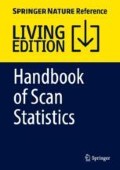Abstract
The spatial scan statistic is one of the most important methods to detect and monitor spatial disease clusters. Usually it is assumed that disease cases follow a Poisson, Binomial, Bernoulli, or negative binomial distribution. In practice, however, case count datasets frequently present zero inflation and/or dispersion (underdispersion or overdispersion), resulting in the violation of those commonly used models, thus increasing type I error occurrence. This paper describes the spatial scan statistic with the zero inflation and dispersion (ScanZID) to accommodate simultaneously the excess of zeroes and dispersion. The null and alternative model parameters are estimated by the expectation-maximization (EM) algorithm, and the p-value is obtained through the fast double bootstrap test. An application is presented for Hanseniasis data in the Brazilian Amazon.
References
Cançado ALF, da-Silva CQ, da Silva MF (2011) A zero-inflated Poisson-based spatial scan statistic. Emerg Health Threats J 2011:4
Cançado, André LF, da-Silva, Cibele Q, Silva, Michel F (2014) A spatial scan statistic for zero-inflated Poisson process. Envir Ecol Stat 21:627–650
Cheung YB (2002) Zero-inflated models for regression analysis of count data: a study of growth and development. Stat Med 21:1461–1469
Consul PC, Jain GC (1973) A generalization of the Poisson distribution. Technometrics 15(4):791–799
Davidson R, MacKinnon JG (2001) Improving the reliability of bootstrap tests. Queen’s University Institute for Economic Research Discussion Paper, No.995, revised
Dias DS, Braga SE, Bandeira CZR, Neto JC, Lima MS (2016, submitted) Zero-inflated double poisson GARMA applied to forecast of dengue cases
Dias DS, Braga SE, Bandeira CZR, Neto JC, Lima MS (2017 submitted) Zero-Inflated double poisson GARMA applied to forecast of dengue cases
Duczmal L, Kulldorff M, Huang L (2006) Evaluation of spatial scan statistics for irregularly shaped disease clusters. J Comput Graph Stat 15:428–442
Duczmal LH, Moreira GJP, Burgarelli D, Takahashi RHC, Magalhães FCO, Bodevan EC (2011) Voronoi distance based prospective space-time scans for point data sets: a dengue fever cluster analysis in a southeast Brazilian town. Int J Health Geogr 10:29
Efron B (1986) Double exponential families and their use in generalized linear regression. JASA 81:709–721
Hall DB (2000) Zero inflated Poisson and binomial regression with random effects: a case study. Biometrics 56:1030–1039
Heinen A (2003) Modelling time series count data: an autoregressive conditional Poisson model. CORE Discussion Paper No.2003–63, University of Louvain, Belgium
Hossian MM, Lawson AB (2006) Cluster detection diagnostics for small area health data, with reference to evaluation of local likelihood models. Stat Med 25:771–786
Jung I (2009) A generalized linear models approach to spatial scan statistics for covariate adjustment. Stat Med 28:1131–1143
Kulldorff M (1997) A spatial scan statistic. Commun Stat Theory Methods 26:1481–1496
Kulldorff M (1999) Spatial scan statistics: models, calculations and applications. In: Glaz J, Balakrishnan N (eds) Scan statistics and applications. Birkhauser, Boston, pp 303–322
Lima M, Ducma L, Neto J, Pinto L (2015) Spatial scan statistics for models with overdispersion and inflated zeros. Stat Sin 25:225–241
Loh JM, Zhu Z (2007) Accounting for spatial correlation in the scan statistic. Ann Appl Stat 1(2):560–584
Xu HY, Xiea M, Goha TN, Fub X (2012) A model for integer-valued time series with conditional overdispersion. Comput Stat Data Anal 56(12):4229–4242
Yau KKW, Lee AH, Carrivick PJW (2004) Modeling zero-inflated count series with application to occupational health. Comput Methods Programs Biomed 74:47–52
Zhang T, Lin G (2009) Spatial scan statistics in loglinear models. Comput Stat Data Anal 53:2851–2858
Zhang T, Zhang Z, Lin G (2012) Spatial scan statistics with overdispersion. Stat Med 31(8):762–774
Zhang T, Zhang Z, Lin G (2012) Spatial scan statistics with overdispersion. Stat Med 2(8):762–774
Acknowledgements
The authors were funded with grants from the Brazilian agencies CAPES, CNPq, FAPEAM, and FAPEMIG.
Author information
Authors and Affiliations
Corresponding author
Editor information
Editors and Affiliations
Section Editor information
Rights and permissions
Copyright information
© 2017 Springer Science+Business Media LLC
About this entry
Cite this entry
de Lima, M.S., Duczmal, L.H., Neto, J.C., Pinto, L.P., Ferreira, M.A.C., de Lima, V.A. (2017). ScanZID: Spatial Scan Statistics with Zero Inflation and Dispersion. In: Glaz, J., Koutras, M. (eds) Handbook of Scan Statistics. Springer, New York, NY. https://doi.org/10.1007/978-1-4614-8414-1_41-1
Download citation
DOI: https://doi.org/10.1007/978-1-4614-8414-1_41-1
Received:
Accepted:
Published:
Publisher Name: Springer, New York, NY
Print ISBN: 978-1-4614-8414-1
Online ISBN: 978-1-4614-8414-1
eBook Packages: Springer Reference MathematicsReference Module Computer Science and Engineering

